Sociological Analysis of Domestic Violence and Policy Measures
VerifiedAdded on 2022/11/26
|10
|2778
|144
Report
AI Summary
This report delves into the multifaceted issue of domestic violence, presenting it within a global context while highlighting its sociological and theoretical underpinnings. It begins by emphasizing the prevalence of domestic and sexual harassment, citing statistics on the number of women affected by physical and emotional abuse from intimate partners. The report then explores the issue through sociological lenses, contrasting the strain and benefit theories with the feminist perspective, which identifies domestic violence as a gendered issue rooted in patriarchal domination. It examines the impact of education and family structure, alongside existing policy structures, particularly in Australia, referencing the Family Law Act of 1975 and the Domestic and Family Protection Act of 2012. The report discusses the National Plan to Reduce Violence Against Women and their Children, its goals, and its shortcomings, especially regarding the long-term impacts on victims' health and well-being. It also addresses the role of social policies, inequality, and the influence of masculinity and gender norms in perpetuating violence, concluding with a call for a deeper understanding of power dynamics to effectively address the issue.
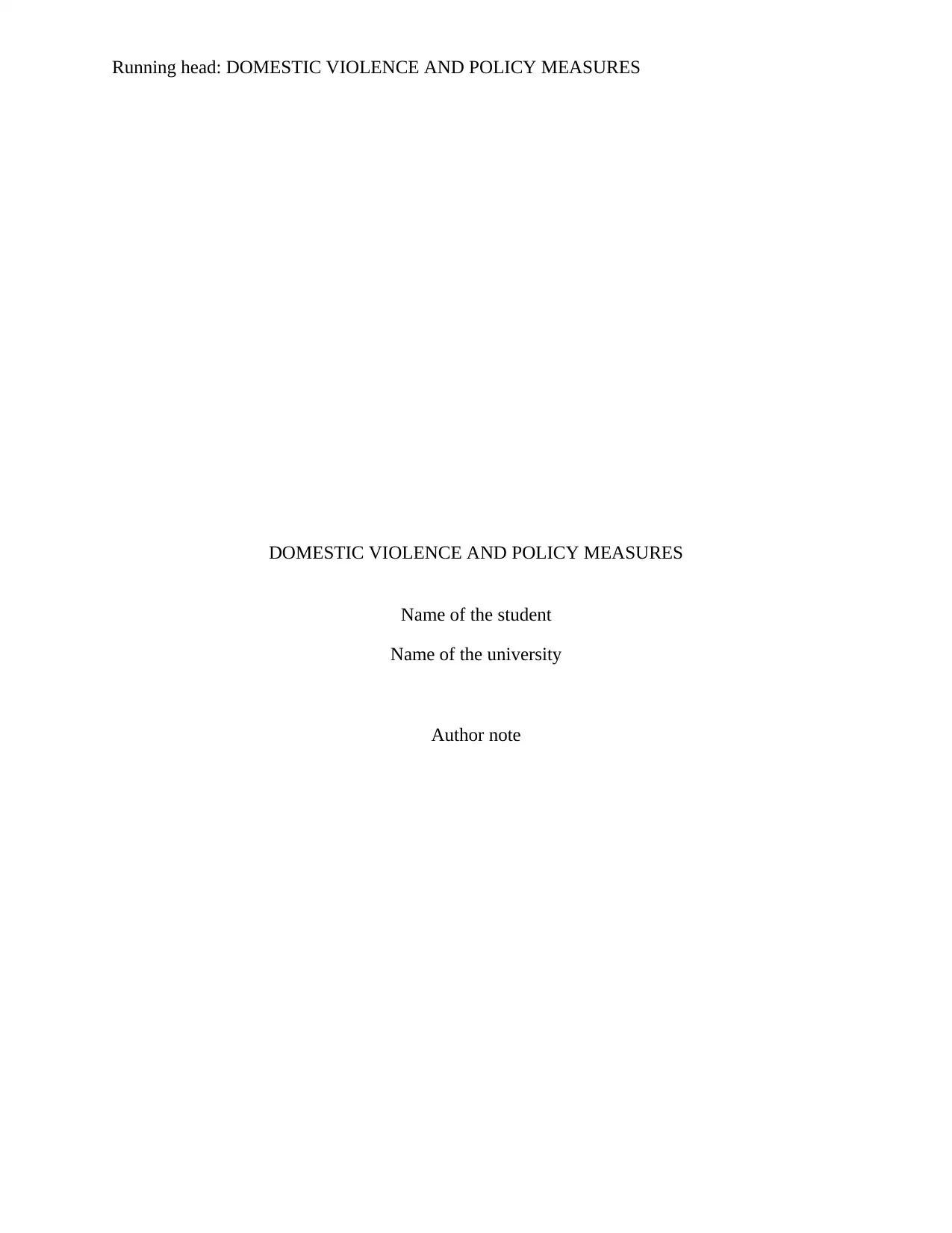
Running head: DOMESTIC VIOLENCE AND POLICY MEASURES
DOMESTIC VIOLENCE AND POLICY MEASURES
Name of the student
Name of the university
Author note
DOMESTIC VIOLENCE AND POLICY MEASURES
Name of the student
Name of the university
Author note
Paraphrase This Document
Need a fresh take? Get an instant paraphrase of this document with our AI Paraphraser
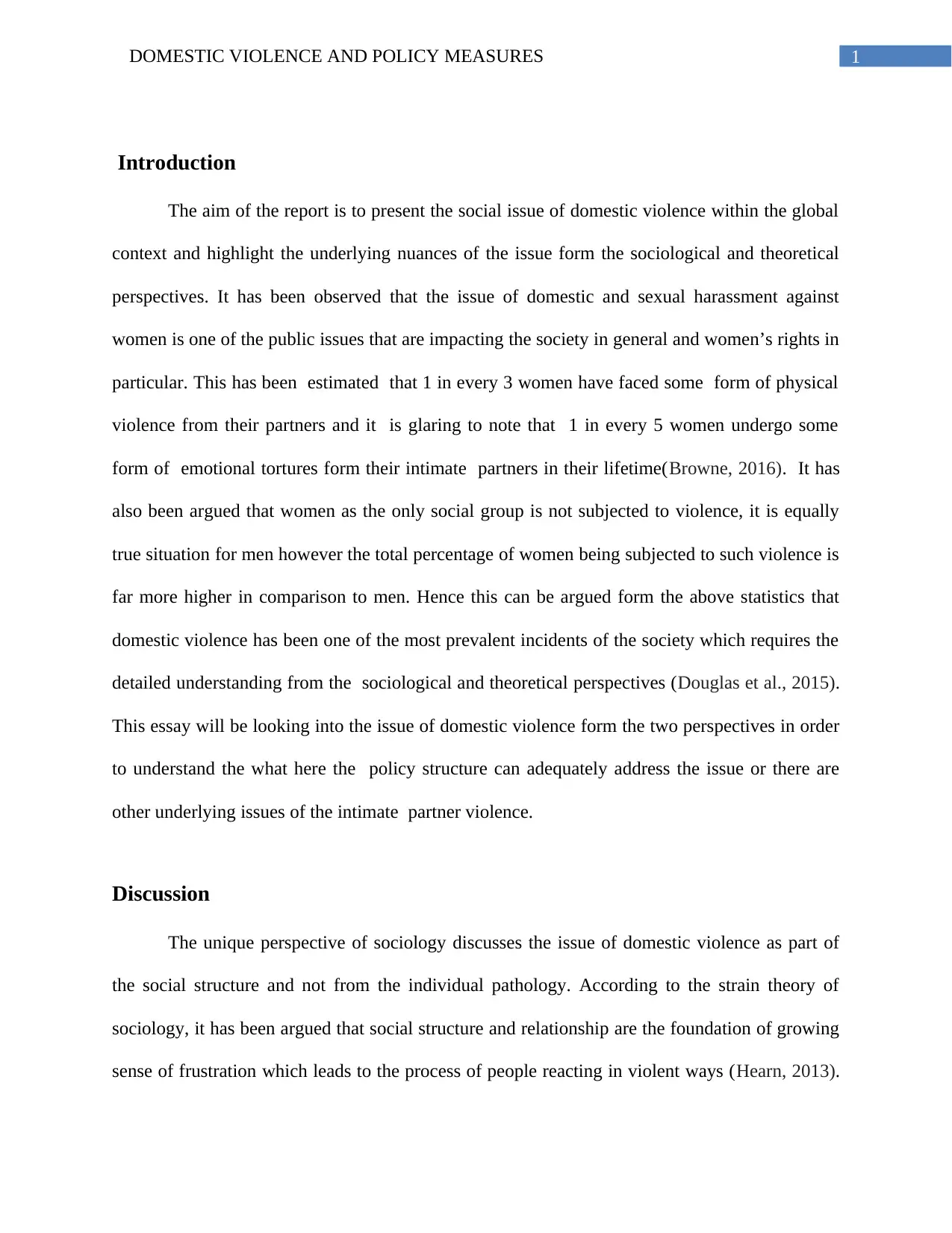
1DOMESTIC VIOLENCE AND POLICY MEASURES
Introduction
The aim of the report is to present the social issue of domestic violence within the global
context and highlight the underlying nuances of the issue form the sociological and theoretical
perspectives. It has been observed that the issue of domestic and sexual harassment against
women is one of the public issues that are impacting the society in general and women’s rights in
particular. This has been estimated that 1 in every 3 women have faced some form of physical
violence from their partners and it is glaring to note that 1 in every 5 women undergo some
form of emotional tortures form their intimate partners in their lifetime(Browne, 2016). It has
also been argued that women as the only social group is not subjected to violence, it is equally
true situation for men however the total percentage of women being subjected to such violence is
far more higher in comparison to men. Hence this can be argued form the above statistics that
domestic violence has been one of the most prevalent incidents of the society which requires the
detailed understanding from the sociological and theoretical perspectives (Douglas et al., 2015).
This essay will be looking into the issue of domestic violence form the two perspectives in order
to understand the what here the policy structure can adequately address the issue or there are
other underlying issues of the intimate partner violence.
Discussion
The unique perspective of sociology discusses the issue of domestic violence as part of
the social structure and not from the individual pathology. According to the strain theory of
sociology, it has been argued that social structure and relationship are the foundation of growing
sense of frustration which leads to the process of people reacting in violent ways (Hearn, 2013).
Introduction
The aim of the report is to present the social issue of domestic violence within the global
context and highlight the underlying nuances of the issue form the sociological and theoretical
perspectives. It has been observed that the issue of domestic and sexual harassment against
women is one of the public issues that are impacting the society in general and women’s rights in
particular. This has been estimated that 1 in every 3 women have faced some form of physical
violence from their partners and it is glaring to note that 1 in every 5 women undergo some
form of emotional tortures form their intimate partners in their lifetime(Browne, 2016). It has
also been argued that women as the only social group is not subjected to violence, it is equally
true situation for men however the total percentage of women being subjected to such violence is
far more higher in comparison to men. Hence this can be argued form the above statistics that
domestic violence has been one of the most prevalent incidents of the society which requires the
detailed understanding from the sociological and theoretical perspectives (Douglas et al., 2015).
This essay will be looking into the issue of domestic violence form the two perspectives in order
to understand the what here the policy structure can adequately address the issue or there are
other underlying issues of the intimate partner violence.
Discussion
The unique perspective of sociology discusses the issue of domestic violence as part of
the social structure and not from the individual pathology. According to the strain theory of
sociology, it has been argued that social structure and relationship are the foundation of growing
sense of frustration which leads to the process of people reacting in violent ways (Hearn, 2013).
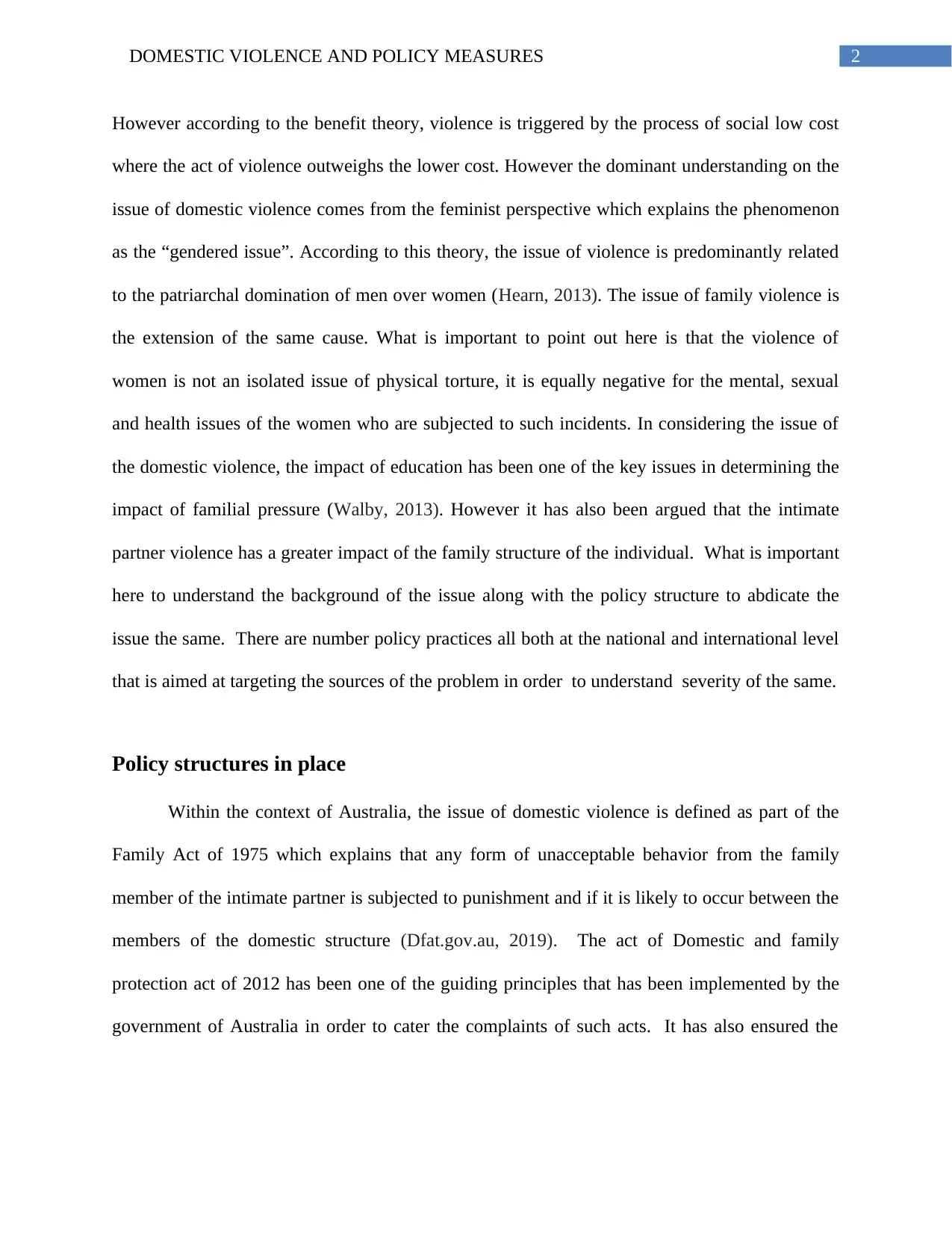
2DOMESTIC VIOLENCE AND POLICY MEASURES
However according to the benefit theory, violence is triggered by the process of social low cost
where the act of violence outweighs the lower cost. However the dominant understanding on the
issue of domestic violence comes from the feminist perspective which explains the phenomenon
as the “gendered issue”. According to this theory, the issue of violence is predominantly related
to the patriarchal domination of men over women (Hearn, 2013). The issue of family violence is
the extension of the same cause. What is important to point out here is that the violence of
women is not an isolated issue of physical torture, it is equally negative for the mental, sexual
and health issues of the women who are subjected to such incidents. In considering the issue of
the domestic violence, the impact of education has been one of the key issues in determining the
impact of familial pressure (Walby, 2013). However it has also been argued that the intimate
partner violence has a greater impact of the family structure of the individual. What is important
here to understand the background of the issue along with the policy structure to abdicate the
issue the same. There are number policy practices all both at the national and international level
that is aimed at targeting the sources of the problem in order to understand severity of the same.
Policy structures in place
Within the context of Australia, the issue of domestic violence is defined as part of the
Family Act of 1975 which explains that any form of unacceptable behavior from the family
member of the intimate partner is subjected to punishment and if it is likely to occur between the
members of the domestic structure (Dfat.gov.au, 2019). The act of Domestic and family
protection act of 2012 has been one of the guiding principles that has been implemented by the
government of Australia in order to cater the complaints of such acts. It has also ensured the
However according to the benefit theory, violence is triggered by the process of social low cost
where the act of violence outweighs the lower cost. However the dominant understanding on the
issue of domestic violence comes from the feminist perspective which explains the phenomenon
as the “gendered issue”. According to this theory, the issue of violence is predominantly related
to the patriarchal domination of men over women (Hearn, 2013). The issue of family violence is
the extension of the same cause. What is important to point out here is that the violence of
women is not an isolated issue of physical torture, it is equally negative for the mental, sexual
and health issues of the women who are subjected to such incidents. In considering the issue of
the domestic violence, the impact of education has been one of the key issues in determining the
impact of familial pressure (Walby, 2013). However it has also been argued that the intimate
partner violence has a greater impact of the family structure of the individual. What is important
here to understand the background of the issue along with the policy structure to abdicate the
issue the same. There are number policy practices all both at the national and international level
that is aimed at targeting the sources of the problem in order to understand severity of the same.
Policy structures in place
Within the context of Australia, the issue of domestic violence is defined as part of the
Family Act of 1975 which explains that any form of unacceptable behavior from the family
member of the intimate partner is subjected to punishment and if it is likely to occur between the
members of the domestic structure (Dfat.gov.au, 2019). The act of Domestic and family
protection act of 2012 has been one of the guiding principles that has been implemented by the
government of Australia in order to cater the complaints of such acts. It has also ensured the
⊘ This is a preview!⊘
Do you want full access?
Subscribe today to unlock all pages.

Trusted by 1+ million students worldwide
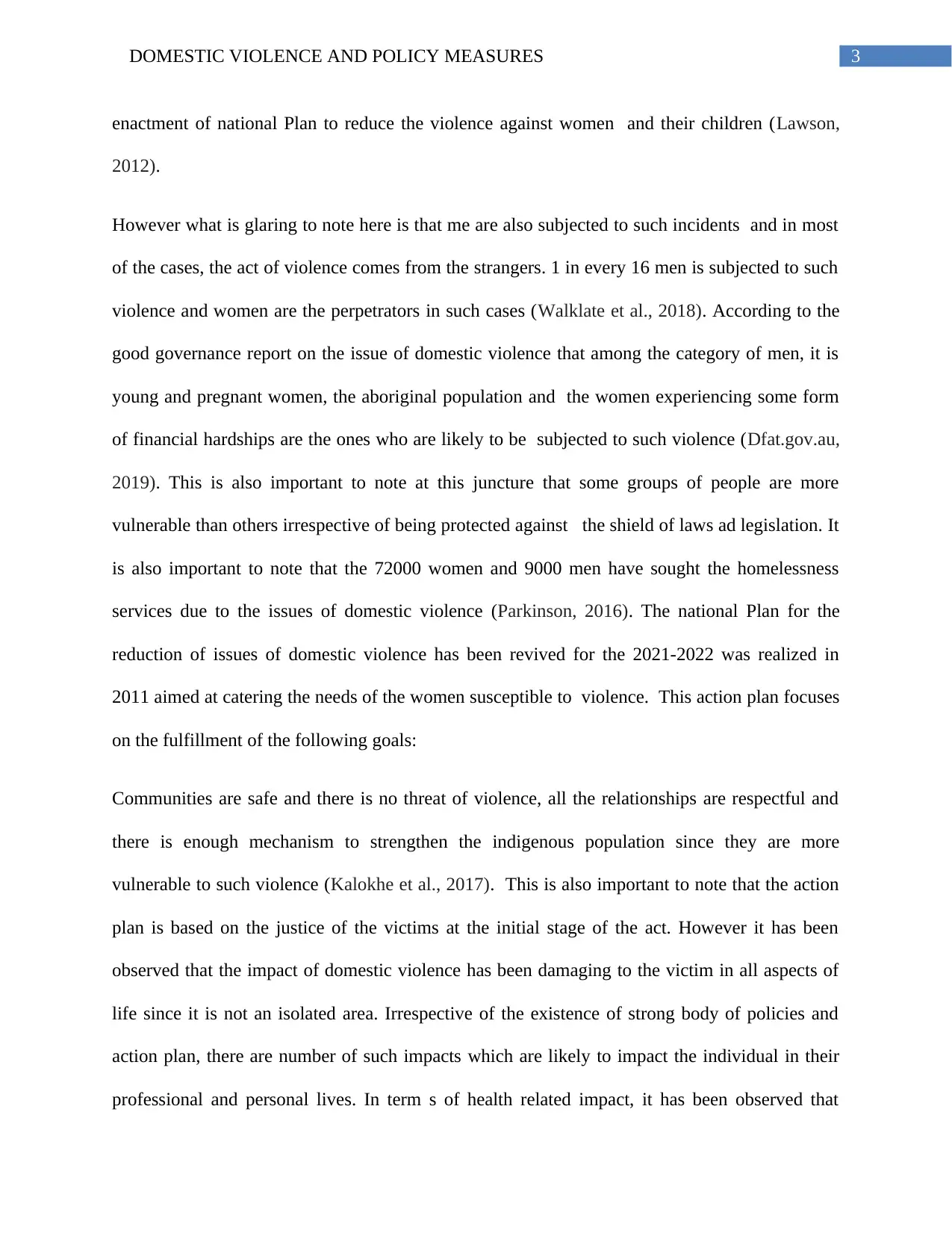
3DOMESTIC VIOLENCE AND POLICY MEASURES
enactment of national Plan to reduce the violence against women and their children (Lawson,
2012).
However what is glaring to note here is that me are also subjected to such incidents and in most
of the cases, the act of violence comes from the strangers. 1 in every 16 men is subjected to such
violence and women are the perpetrators in such cases (Walklate et al., 2018). According to the
good governance report on the issue of domestic violence that among the category of men, it is
young and pregnant women, the aboriginal population and the women experiencing some form
of financial hardships are the ones who are likely to be subjected to such violence (Dfat.gov.au,
2019). This is also important to note at this juncture that some groups of people are more
vulnerable than others irrespective of being protected against the shield of laws ad legislation. It
is also important to note that the 72000 women and 9000 men have sought the homelessness
services due to the issues of domestic violence (Parkinson, 2016). The national Plan for the
reduction of issues of domestic violence has been revived for the 2021-2022 was realized in
2011 aimed at catering the needs of the women susceptible to violence. This action plan focuses
on the fulfillment of the following goals:
Communities are safe and there is no threat of violence, all the relationships are respectful and
there is enough mechanism to strengthen the indigenous population since they are more
vulnerable to such violence (Kalokhe et al., 2017). This is also important to note that the action
plan is based on the justice of the victims at the initial stage of the act. However it has been
observed that the impact of domestic violence has been damaging to the victim in all aspects of
life since it is not an isolated area. Irrespective of the existence of strong body of policies and
action plan, there are number of such impacts which are likely to impact the individual in their
professional and personal lives. In term s of health related impact, it has been observed that
enactment of national Plan to reduce the violence against women and their children (Lawson,
2012).
However what is glaring to note here is that me are also subjected to such incidents and in most
of the cases, the act of violence comes from the strangers. 1 in every 16 men is subjected to such
violence and women are the perpetrators in such cases (Walklate et al., 2018). According to the
good governance report on the issue of domestic violence that among the category of men, it is
young and pregnant women, the aboriginal population and the women experiencing some form
of financial hardships are the ones who are likely to be subjected to such violence (Dfat.gov.au,
2019). This is also important to note at this juncture that some groups of people are more
vulnerable than others irrespective of being protected against the shield of laws ad legislation. It
is also important to note that the 72000 women and 9000 men have sought the homelessness
services due to the issues of domestic violence (Parkinson, 2016). The national Plan for the
reduction of issues of domestic violence has been revived for the 2021-2022 was realized in
2011 aimed at catering the needs of the women susceptible to violence. This action plan focuses
on the fulfillment of the following goals:
Communities are safe and there is no threat of violence, all the relationships are respectful and
there is enough mechanism to strengthen the indigenous population since they are more
vulnerable to such violence (Kalokhe et al., 2017). This is also important to note that the action
plan is based on the justice of the victims at the initial stage of the act. However it has been
observed that the impact of domestic violence has been damaging to the victim in all aspects of
life since it is not an isolated area. Irrespective of the existence of strong body of policies and
action plan, there are number of such impacts which are likely to impact the individual in their
professional and personal lives. In term s of health related impact, it has been observed that
Paraphrase This Document
Need a fresh take? Get an instant paraphrase of this document with our AI Paraphraser
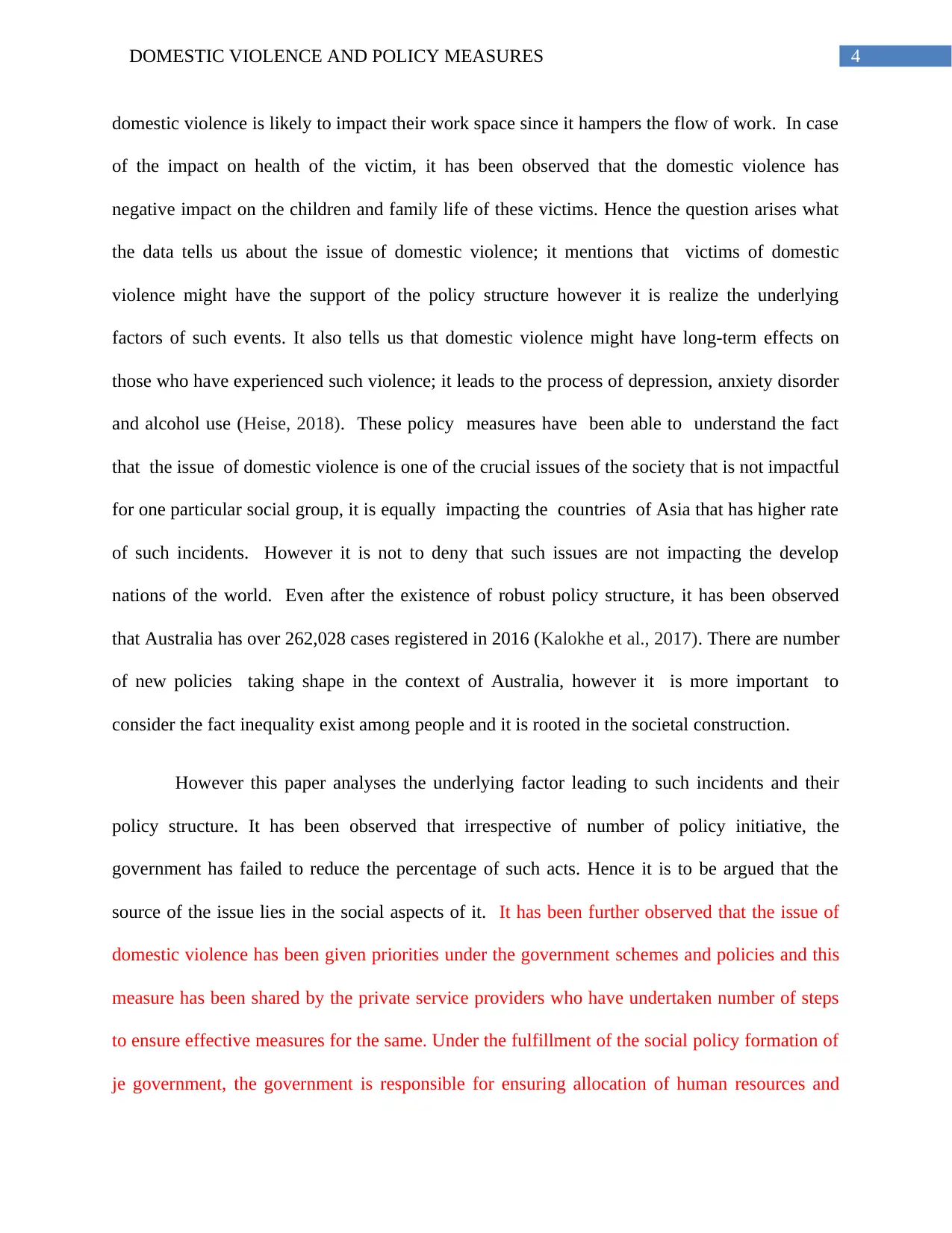
4DOMESTIC VIOLENCE AND POLICY MEASURES
domestic violence is likely to impact their work space since it hampers the flow of work. In case
of the impact on health of the victim, it has been observed that the domestic violence has
negative impact on the children and family life of these victims. Hence the question arises what
the data tells us about the issue of domestic violence; it mentions that victims of domestic
violence might have the support of the policy structure however it is realize the underlying
factors of such events. It also tells us that domestic violence might have long-term effects on
those who have experienced such violence; it leads to the process of depression, anxiety disorder
and alcohol use (Heise, 2018). These policy measures have been able to understand the fact
that the issue of domestic violence is one of the crucial issues of the society that is not impactful
for one particular social group, it is equally impacting the countries of Asia that has higher rate
of such incidents. However it is not to deny that such issues are not impacting the develop
nations of the world. Even after the existence of robust policy structure, it has been observed
that Australia has over 262,028 cases registered in 2016 (Kalokhe et al., 2017). There are number
of new policies taking shape in the context of Australia, however it is more important to
consider the fact inequality exist among people and it is rooted in the societal construction.
However this paper analyses the underlying factor leading to such incidents and their
policy structure. It has been observed that irrespective of number of policy initiative, the
government has failed to reduce the percentage of such acts. Hence it is to be argued that the
source of the issue lies in the social aspects of it. It has been further observed that the issue of
domestic violence has been given priorities under the government schemes and policies and this
measure has been shared by the private service providers who have undertaken number of steps
to ensure effective measures for the same. Under the fulfillment of the social policy formation of
je government, the government is responsible for ensuring allocation of human resources and
domestic violence is likely to impact their work space since it hampers the flow of work. In case
of the impact on health of the victim, it has been observed that the domestic violence has
negative impact on the children and family life of these victims. Hence the question arises what
the data tells us about the issue of domestic violence; it mentions that victims of domestic
violence might have the support of the policy structure however it is realize the underlying
factors of such events. It also tells us that domestic violence might have long-term effects on
those who have experienced such violence; it leads to the process of depression, anxiety disorder
and alcohol use (Heise, 2018). These policy measures have been able to understand the fact
that the issue of domestic violence is one of the crucial issues of the society that is not impactful
for one particular social group, it is equally impacting the countries of Asia that has higher rate
of such incidents. However it is not to deny that such issues are not impacting the develop
nations of the world. Even after the existence of robust policy structure, it has been observed
that Australia has over 262,028 cases registered in 2016 (Kalokhe et al., 2017). There are number
of new policies taking shape in the context of Australia, however it is more important to
consider the fact inequality exist among people and it is rooted in the societal construction.
However this paper analyses the underlying factor leading to such incidents and their
policy structure. It has been observed that irrespective of number of policy initiative, the
government has failed to reduce the percentage of such acts. Hence it is to be argued that the
source of the issue lies in the social aspects of it. It has been further observed that the issue of
domestic violence has been given priorities under the government schemes and policies and this
measure has been shared by the private service providers who have undertaken number of steps
to ensure effective measures for the same. Under the fulfillment of the social policy formation of
je government, the government is responsible for ensuring allocation of human resources and
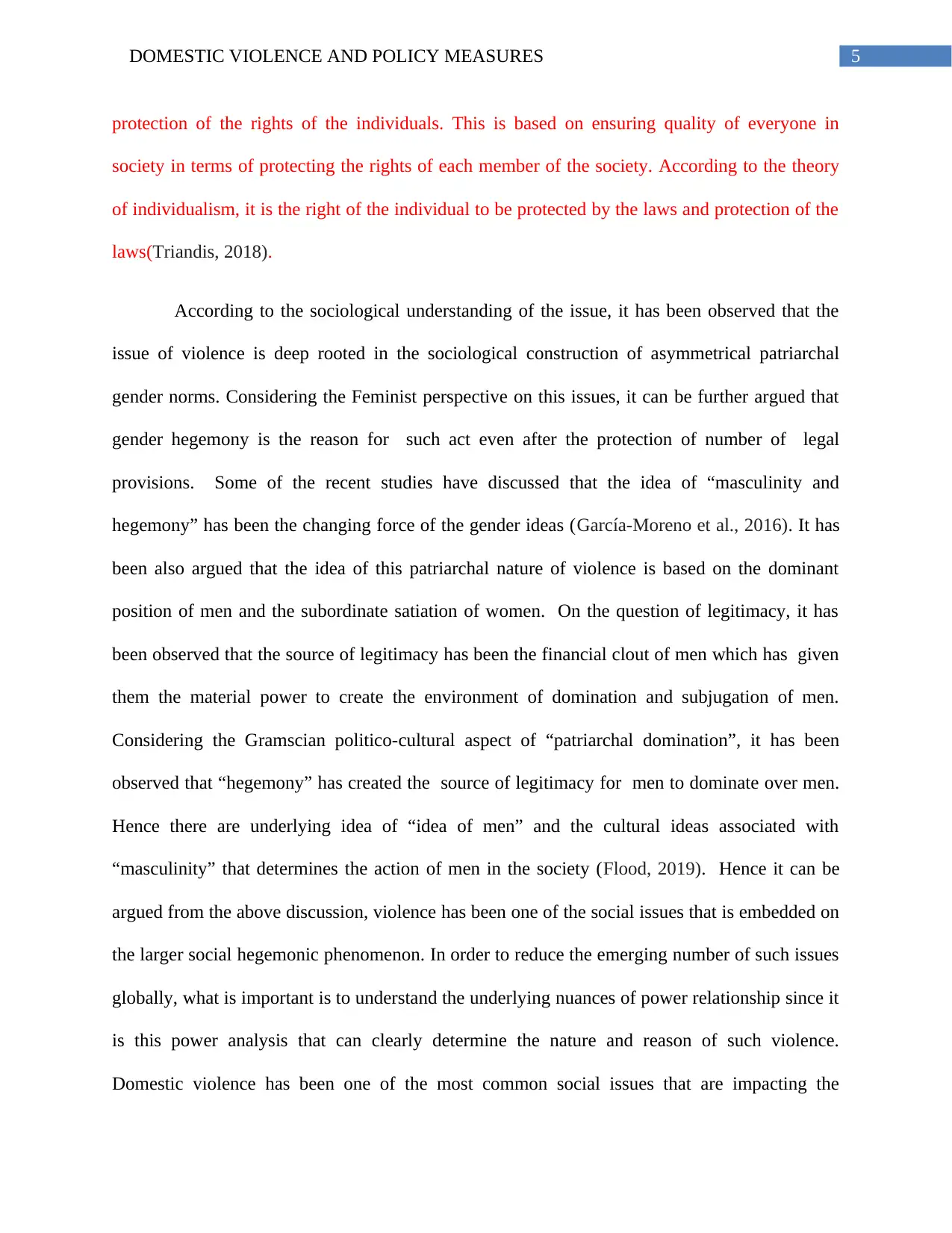
5DOMESTIC VIOLENCE AND POLICY MEASURES
protection of the rights of the individuals. This is based on ensuring quality of everyone in
society in terms of protecting the rights of each member of the society. According to the theory
of individualism, it is the right of the individual to be protected by the laws and protection of the
laws(Triandis, 2018).
According to the sociological understanding of the issue, it has been observed that the
issue of violence is deep rooted in the sociological construction of asymmetrical patriarchal
gender norms. Considering the Feminist perspective on this issues, it can be further argued that
gender hegemony is the reason for such act even after the protection of number of legal
provisions. Some of the recent studies have discussed that the idea of “masculinity and
hegemony” has been the changing force of the gender ideas (García-Moreno et al., 2016). It has
been also argued that the idea of this patriarchal nature of violence is based on the dominant
position of men and the subordinate satiation of women. On the question of legitimacy, it has
been observed that the source of legitimacy has been the financial clout of men which has given
them the material power to create the environment of domination and subjugation of men.
Considering the Gramscian politico-cultural aspect of “patriarchal domination”, it has been
observed that “hegemony” has created the source of legitimacy for men to dominate over men.
Hence there are underlying idea of “idea of men” and the cultural ideas associated with
“masculinity” that determines the action of men in the society (Flood, 2019). Hence it can be
argued from the above discussion, violence has been one of the social issues that is embedded on
the larger social hegemonic phenomenon. In order to reduce the emerging number of such issues
globally, what is important is to understand the underlying nuances of power relationship since it
is this power analysis that can clearly determine the nature and reason of such violence.
Domestic violence has been one of the most common social issues that are impacting the
protection of the rights of the individuals. This is based on ensuring quality of everyone in
society in terms of protecting the rights of each member of the society. According to the theory
of individualism, it is the right of the individual to be protected by the laws and protection of the
laws(Triandis, 2018).
According to the sociological understanding of the issue, it has been observed that the
issue of violence is deep rooted in the sociological construction of asymmetrical patriarchal
gender norms. Considering the Feminist perspective on this issues, it can be further argued that
gender hegemony is the reason for such act even after the protection of number of legal
provisions. Some of the recent studies have discussed that the idea of “masculinity and
hegemony” has been the changing force of the gender ideas (García-Moreno et al., 2016). It has
been also argued that the idea of this patriarchal nature of violence is based on the dominant
position of men and the subordinate satiation of women. On the question of legitimacy, it has
been observed that the source of legitimacy has been the financial clout of men which has given
them the material power to create the environment of domination and subjugation of men.
Considering the Gramscian politico-cultural aspect of “patriarchal domination”, it has been
observed that “hegemony” has created the source of legitimacy for men to dominate over men.
Hence there are underlying idea of “idea of men” and the cultural ideas associated with
“masculinity” that determines the action of men in the society (Flood, 2019). Hence it can be
argued from the above discussion, violence has been one of the social issues that is embedded on
the larger social hegemonic phenomenon. In order to reduce the emerging number of such issues
globally, what is important is to understand the underlying nuances of power relationship since it
is this power analysis that can clearly determine the nature and reason of such violence.
Domestic violence has been one of the most common social issues that are impacting the
⊘ This is a preview!⊘
Do you want full access?
Subscribe today to unlock all pages.

Trusted by 1+ million students worldwide
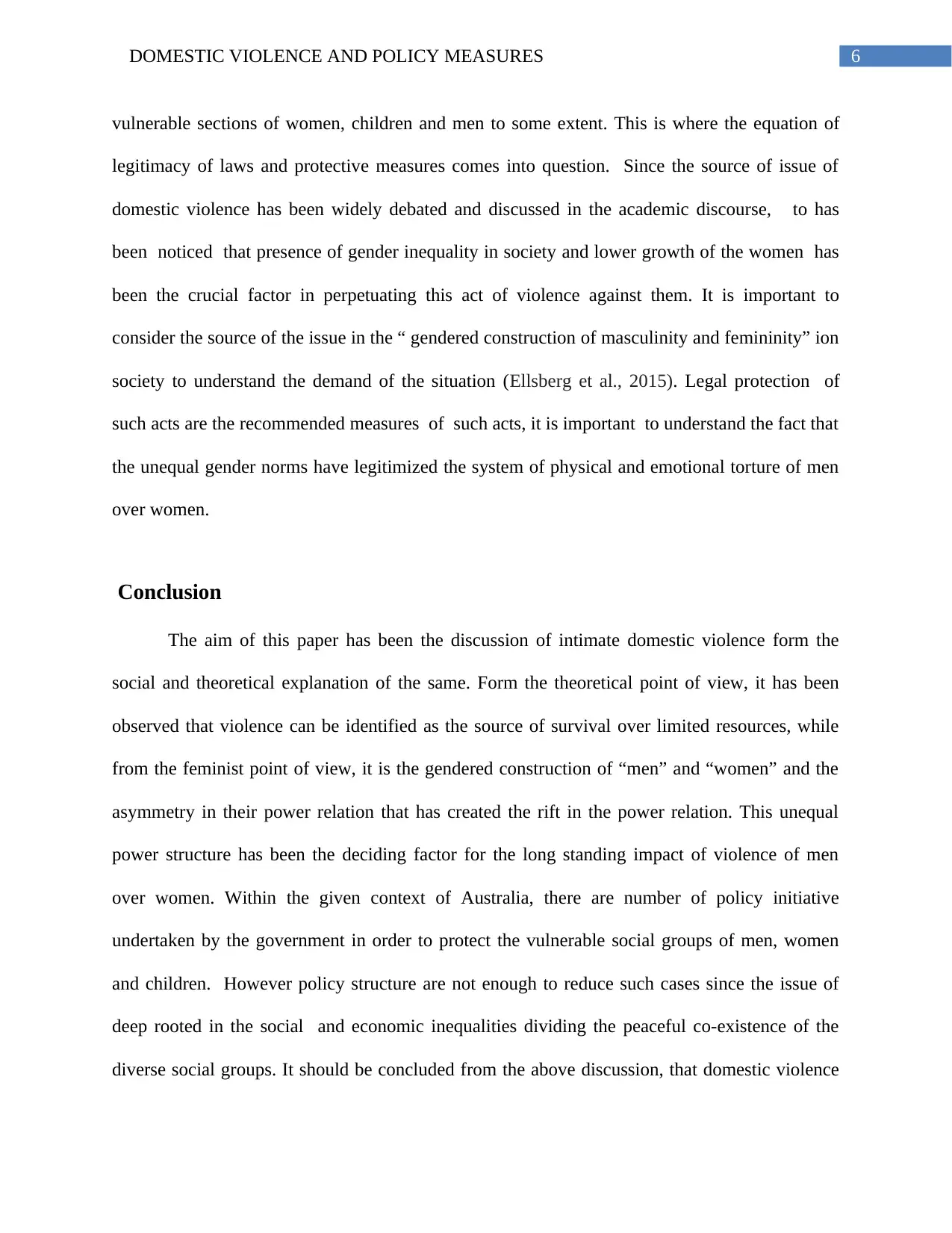
6DOMESTIC VIOLENCE AND POLICY MEASURES
vulnerable sections of women, children and men to some extent. This is where the equation of
legitimacy of laws and protective measures comes into question. Since the source of issue of
domestic violence has been widely debated and discussed in the academic discourse, to has
been noticed that presence of gender inequality in society and lower growth of the women has
been the crucial factor in perpetuating this act of violence against them. It is important to
consider the source of the issue in the “ gendered construction of masculinity and femininity” ion
society to understand the demand of the situation (Ellsberg et al., 2015). Legal protection of
such acts are the recommended measures of such acts, it is important to understand the fact that
the unequal gender norms have legitimized the system of physical and emotional torture of men
over women.
Conclusion
The aim of this paper has been the discussion of intimate domestic violence form the
social and theoretical explanation of the same. Form the theoretical point of view, it has been
observed that violence can be identified as the source of survival over limited resources, while
from the feminist point of view, it is the gendered construction of “men” and “women” and the
asymmetry in their power relation that has created the rift in the power relation. This unequal
power structure has been the deciding factor for the long standing impact of violence of men
over women. Within the given context of Australia, there are number of policy initiative
undertaken by the government in order to protect the vulnerable social groups of men, women
and children. However policy structure are not enough to reduce such cases since the issue of
deep rooted in the social and economic inequalities dividing the peaceful co-existence of the
diverse social groups. It should be concluded from the above discussion, that domestic violence
vulnerable sections of women, children and men to some extent. This is where the equation of
legitimacy of laws and protective measures comes into question. Since the source of issue of
domestic violence has been widely debated and discussed in the academic discourse, to has
been noticed that presence of gender inequality in society and lower growth of the women has
been the crucial factor in perpetuating this act of violence against them. It is important to
consider the source of the issue in the “ gendered construction of masculinity and femininity” ion
society to understand the demand of the situation (Ellsberg et al., 2015). Legal protection of
such acts are the recommended measures of such acts, it is important to understand the fact that
the unequal gender norms have legitimized the system of physical and emotional torture of men
over women.
Conclusion
The aim of this paper has been the discussion of intimate domestic violence form the
social and theoretical explanation of the same. Form the theoretical point of view, it has been
observed that violence can be identified as the source of survival over limited resources, while
from the feminist point of view, it is the gendered construction of “men” and “women” and the
asymmetry in their power relation that has created the rift in the power relation. This unequal
power structure has been the deciding factor for the long standing impact of violence of men
over women. Within the given context of Australia, there are number of policy initiative
undertaken by the government in order to protect the vulnerable social groups of men, women
and children. However policy structure are not enough to reduce such cases since the issue of
deep rooted in the social and economic inequalities dividing the peaceful co-existence of the
diverse social groups. It should be concluded from the above discussion, that domestic violence
Paraphrase This Document
Need a fresh take? Get an instant paraphrase of this document with our AI Paraphraser
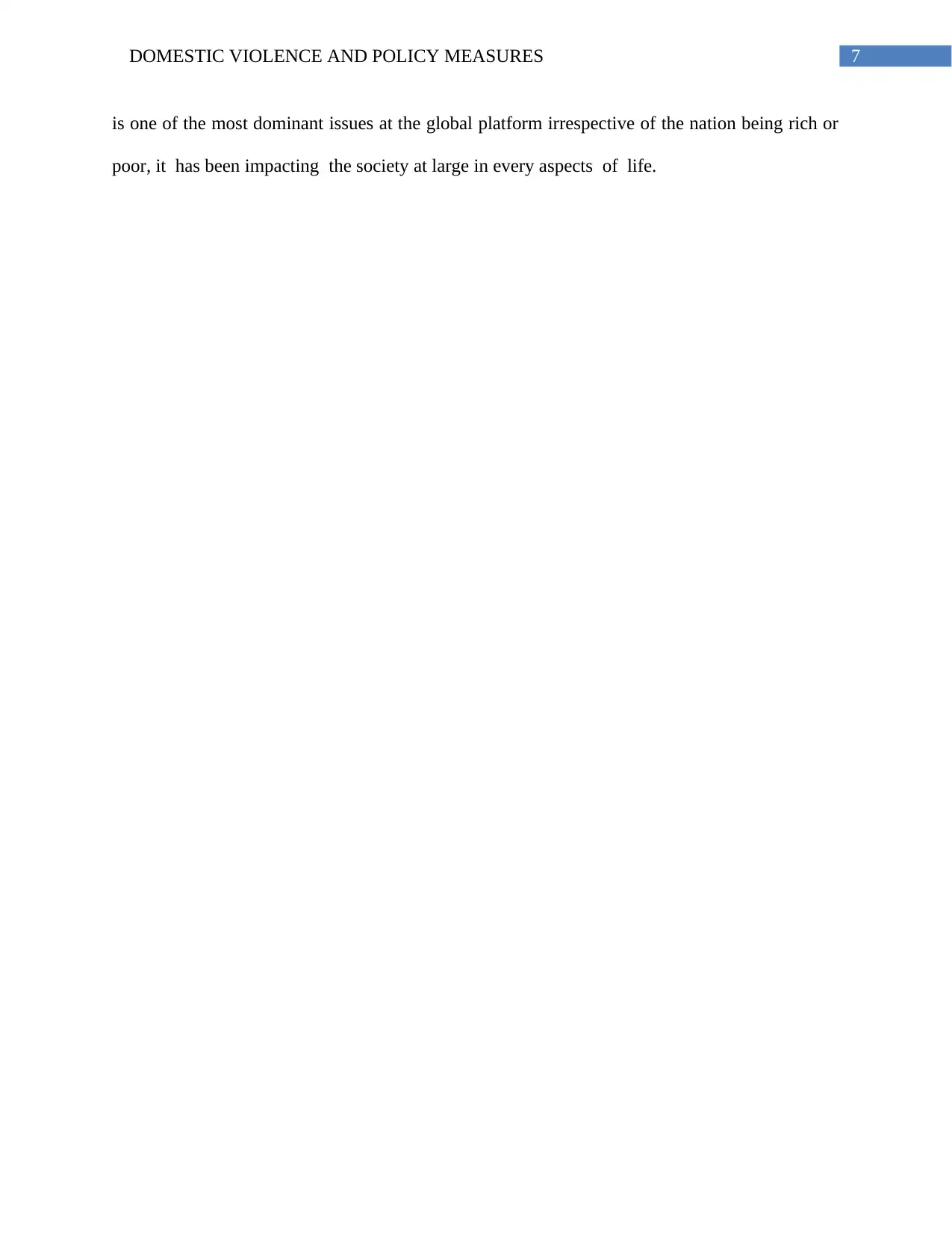
7DOMESTIC VIOLENCE AND POLICY MEASURES
is one of the most dominant issues at the global platform irrespective of the nation being rich or
poor, it has been impacting the society at large in every aspects of life.
is one of the most dominant issues at the global platform irrespective of the nation being rich or
poor, it has been impacting the society at large in every aspects of life.
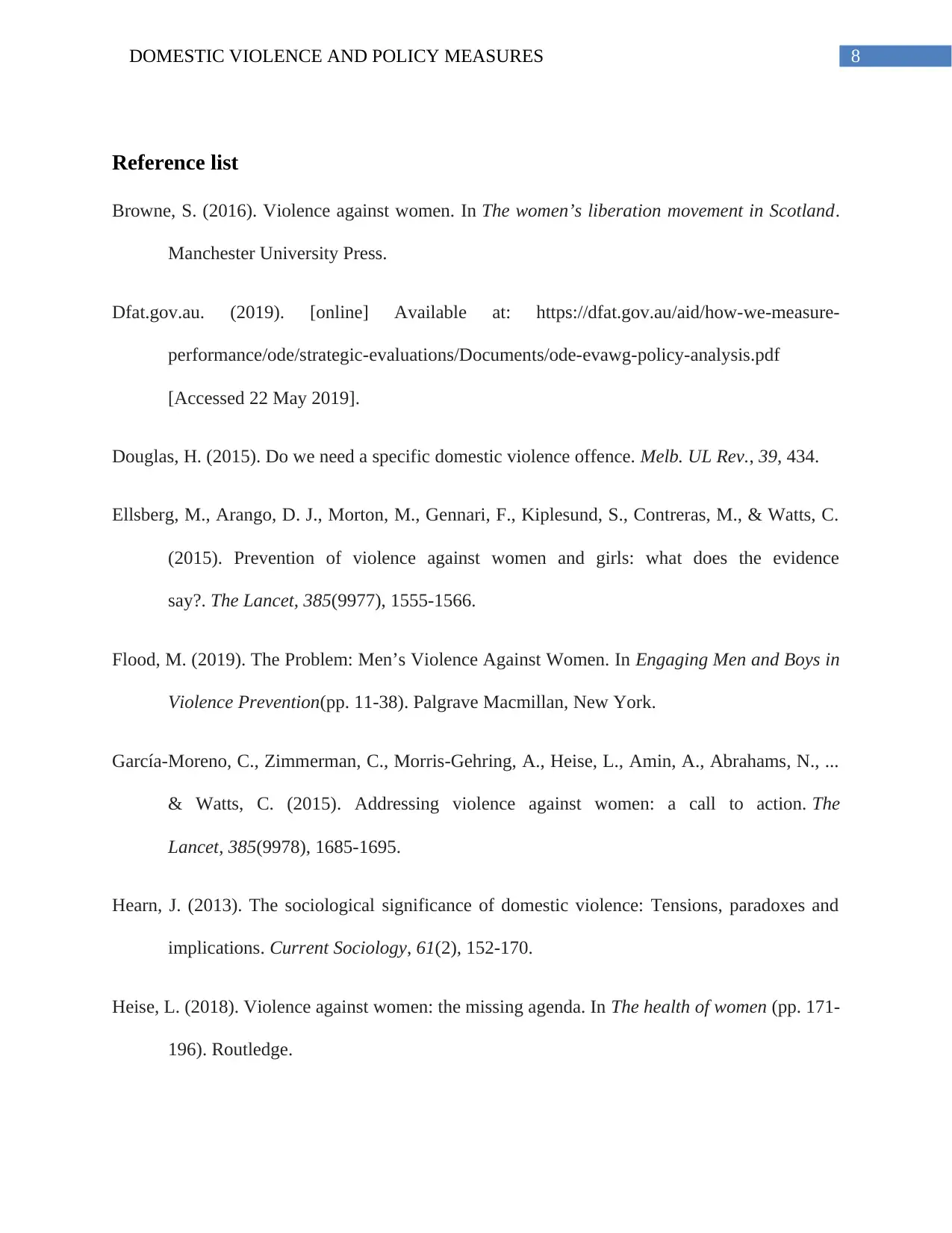
8DOMESTIC VIOLENCE AND POLICY MEASURES
Reference list
Browne, S. (2016). Violence against women. In The women’s liberation movement in Scotland.
Manchester University Press.
Dfat.gov.au. (2019). [online] Available at: https://dfat.gov.au/aid/how-we-measure-
performance/ode/strategic-evaluations/Documents/ode-evawg-policy-analysis.pdf
[Accessed 22 May 2019].
Douglas, H. (2015). Do we need a specific domestic violence offence. Melb. UL Rev., 39, 434.
Ellsberg, M., Arango, D. J., Morton, M., Gennari, F., Kiplesund, S., Contreras, M., & Watts, C.
(2015). Prevention of violence against women and girls: what does the evidence
say?. The Lancet, 385(9977), 1555-1566.
Flood, M. (2019). The Problem: Men’s Violence Against Women. In Engaging Men and Boys in
Violence Prevention(pp. 11-38). Palgrave Macmillan, New York.
García-Moreno, C., Zimmerman, C., Morris-Gehring, A., Heise, L., Amin, A., Abrahams, N., ...
& Watts, C. (2015). Addressing violence against women: a call to action. The
Lancet, 385(9978), 1685-1695.
Hearn, J. (2013). The sociological significance of domestic violence: Tensions, paradoxes and
implications. Current Sociology, 61(2), 152-170.
Heise, L. (2018). Violence against women: the missing agenda. In The health of women (pp. 171-
196). Routledge.
Reference list
Browne, S. (2016). Violence against women. In The women’s liberation movement in Scotland.
Manchester University Press.
Dfat.gov.au. (2019). [online] Available at: https://dfat.gov.au/aid/how-we-measure-
performance/ode/strategic-evaluations/Documents/ode-evawg-policy-analysis.pdf
[Accessed 22 May 2019].
Douglas, H. (2015). Do we need a specific domestic violence offence. Melb. UL Rev., 39, 434.
Ellsberg, M., Arango, D. J., Morton, M., Gennari, F., Kiplesund, S., Contreras, M., & Watts, C.
(2015). Prevention of violence against women and girls: what does the evidence
say?. The Lancet, 385(9977), 1555-1566.
Flood, M. (2019). The Problem: Men’s Violence Against Women. In Engaging Men and Boys in
Violence Prevention(pp. 11-38). Palgrave Macmillan, New York.
García-Moreno, C., Zimmerman, C., Morris-Gehring, A., Heise, L., Amin, A., Abrahams, N., ...
& Watts, C. (2015). Addressing violence against women: a call to action. The
Lancet, 385(9978), 1685-1695.
Hearn, J. (2013). The sociological significance of domestic violence: Tensions, paradoxes and
implications. Current Sociology, 61(2), 152-170.
Heise, L. (2018). Violence against women: the missing agenda. In The health of women (pp. 171-
196). Routledge.
⊘ This is a preview!⊘
Do you want full access?
Subscribe today to unlock all pages.

Trusted by 1+ million students worldwide
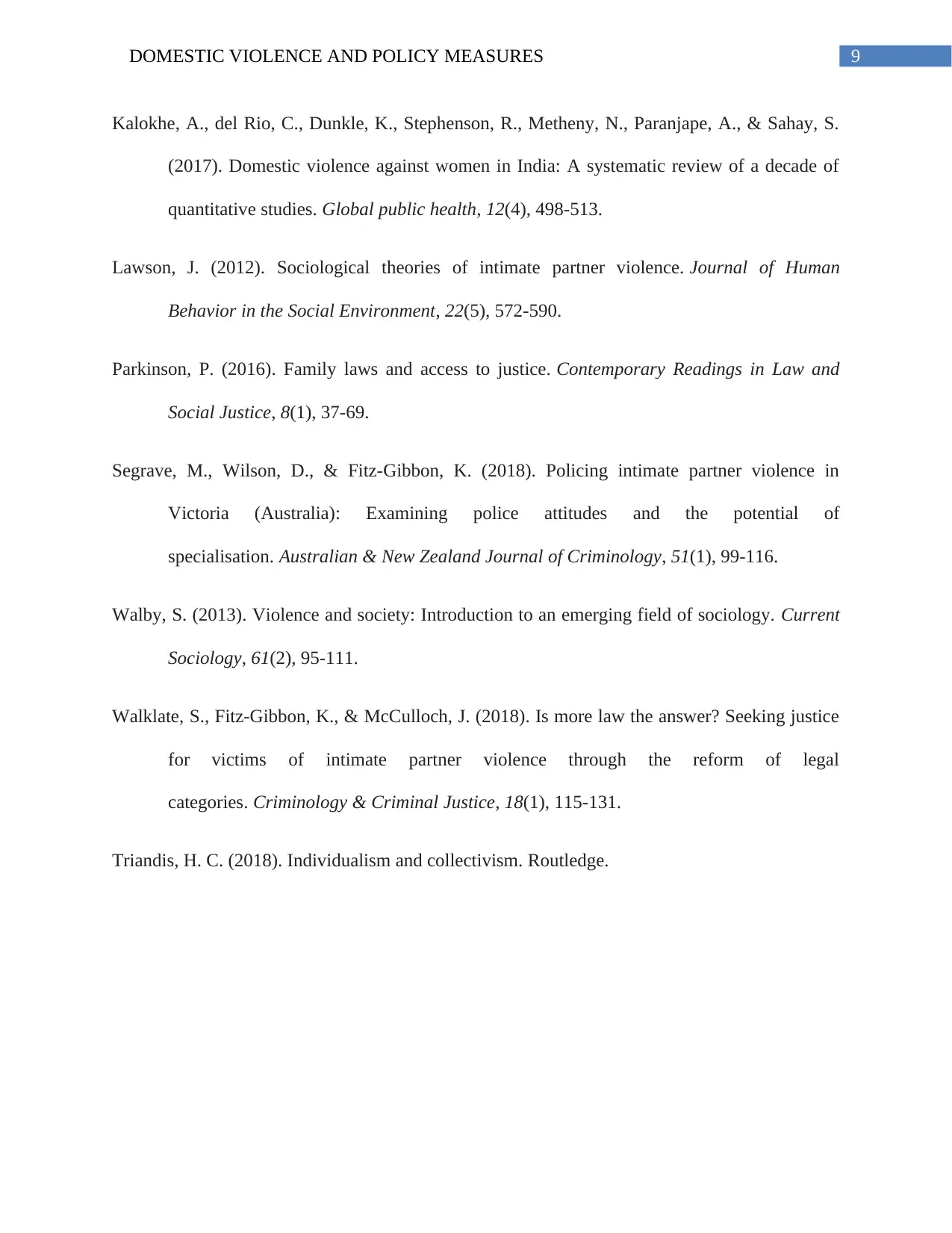
9DOMESTIC VIOLENCE AND POLICY MEASURES
Kalokhe, A., del Rio, C., Dunkle, K., Stephenson, R., Metheny, N., Paranjape, A., & Sahay, S.
(2017). Domestic violence against women in India: A systematic review of a decade of
quantitative studies. Global public health, 12(4), 498-513.
Lawson, J. (2012). Sociological theories of intimate partner violence. Journal of Human
Behavior in the Social Environment, 22(5), 572-590.
Parkinson, P. (2016). Family laws and access to justice. Contemporary Readings in Law and
Social Justice, 8(1), 37-69.
Segrave, M., Wilson, D., & Fitz-Gibbon, K. (2018). Policing intimate partner violence in
Victoria (Australia): Examining police attitudes and the potential of
specialisation. Australian & New Zealand Journal of Criminology, 51(1), 99-116.
Walby, S. (2013). Violence and society: Introduction to an emerging field of sociology. Current
Sociology, 61(2), 95-111.
Walklate, S., Fitz-Gibbon, K., & McCulloch, J. (2018). Is more law the answer? Seeking justice
for victims of intimate partner violence through the reform of legal
categories. Criminology & Criminal Justice, 18(1), 115-131.
Triandis, H. C. (2018). Individualism and collectivism. Routledge.
Kalokhe, A., del Rio, C., Dunkle, K., Stephenson, R., Metheny, N., Paranjape, A., & Sahay, S.
(2017). Domestic violence against women in India: A systematic review of a decade of
quantitative studies. Global public health, 12(4), 498-513.
Lawson, J. (2012). Sociological theories of intimate partner violence. Journal of Human
Behavior in the Social Environment, 22(5), 572-590.
Parkinson, P. (2016). Family laws and access to justice. Contemporary Readings in Law and
Social Justice, 8(1), 37-69.
Segrave, M., Wilson, D., & Fitz-Gibbon, K. (2018). Policing intimate partner violence in
Victoria (Australia): Examining police attitudes and the potential of
specialisation. Australian & New Zealand Journal of Criminology, 51(1), 99-116.
Walby, S. (2013). Violence and society: Introduction to an emerging field of sociology. Current
Sociology, 61(2), 95-111.
Walklate, S., Fitz-Gibbon, K., & McCulloch, J. (2018). Is more law the answer? Seeking justice
for victims of intimate partner violence through the reform of legal
categories. Criminology & Criminal Justice, 18(1), 115-131.
Triandis, H. C. (2018). Individualism and collectivism. Routledge.
1 out of 10
Related Documents
Your All-in-One AI-Powered Toolkit for Academic Success.
+13062052269
info@desklib.com
Available 24*7 on WhatsApp / Email
![[object Object]](/_next/static/media/star-bottom.7253800d.svg)
Unlock your academic potential
Copyright © 2020–2025 A2Z Services. All Rights Reserved. Developed and managed by ZUCOL.





